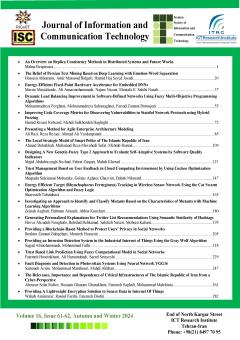Designing A New Genetic-Fuzzy Type 2 Approach to Evaluate Self-Adaptive Systems by Software Quality Indicators
Subject Areas : AI and Robotics
Majid Abdolrazzagh-Nezhad
1
![]() ,
Eshrat Zargari
2
,
Mehdi Kherad
3
,
Eshrat Zargari
2
,
Mehdi Kherad
3
1 - دانشگاه بزرگمهر قائنات
2 - Department of Computer Engineering, Birjand Branch, Islamic Azad University, Birjand, Iran
3 - 2- Ph.D. Student of Information Technology, Faculty of Engineering, Department of computer Engineering, University of Qom, Iran
Keywords: Self-Adaptive System, Quality Indicators of The Software, Genetic Algorithm, fuzzy Type 2, Adaptive traffic control system (ATCS).,
Abstract :
The possibility of developing intelligent systems compatible with the environment has increased by expanding computer engineering fields. Self-adaptive systems are one of the types of software systems that change their behavior according to system conditions and environmental conditions and adapt themselves to it. Although the evaluation of the performance of these systems has been covered in most researches, the evaluation of their quality has remained closed. Therefore, designing an approach is an essential issue to evaluate the quality of self-adaptive systems. The first challenge, the quality indicators of these systems are not fixed, specific, and definite parameters. For example, one of the qualitative indicators for a self-adaptive system is the ability to run software on different operating systems. This indicator may have different degrees of importance for different experienced individuals. The next challenge, some qualitative indicators are not mathematical variables, but rather a linguistic variable between users and experts, indicating that these qualitative quantities are fuzzy variables and can be completely formulated by fuzzy logic. In this article, a new genetic-fuzzy type 2 approach has been proposed to evaluate the quality of the systems based on their quality indicators. The fuzzy logic type 2 is used to describe qualitative indicators, and a genetic algorithm is utilized to determine the optimal fuzzy weights of the qualitative indicators. In the proposed method, it has been tried to compare the self-adaptive systems from two dimensions, including the software dimension and their self-adaptive dimension. This is despite the fact that most of the existing research deals with only one dimension. In order to evaluate the proposed method, a traffic control system called InSync, which is an adaptive traffic control system (ATCS) and contains multiple qualitative factors, has been used. The obtained results confirm the effectiveness of the proposed method due to the lack of scenario generation, the ability to extend the method to all software quality parameters, and its simplicity. Also, the method is more comprehensive than other existing evaluation models. In addition, it has been tried to compare the self-adaptive systems from two dimensions, including the software dimension and their self-adaptive dimension. This is despite the fact that most of the existing research deals with only one dimension.
